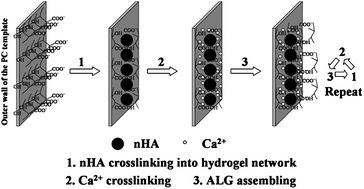Fabrication and biological application of nano-hydroxyapatite (nHA)/alginate (ALG) hydrogel as scaffolds†
Abstract
We have fabricated tubular hydrogel scaffolds of nano-hydroxyapatite (

* Corresponding authors
a
Beijing National Laboratory for Molecular Sciences (BNLMS), International Joint Lab, Key Lab of Colloid and Interface Sciences, Institute of Chemistry, Chinese Academy of Sciences, Zhong Guan Cun, Bei Yi Jie 2, Beijing, China
E-mail:
jbli@iccas.ac.cn
Fax: +86 10 82612629
Tel: +86 10 82614087
b National Center for Nanoscicence and Technology, Beijing, China
We have fabricated tubular hydrogel scaffolds of nano-hydroxyapatite (

 Please wait while we load your content...
Something went wrong. Try again?
Please wait while we load your content...
Something went wrong. Try again?
M. Du, W. Song, Y. Cui, Y. Yang and J. Li, J. Mater. Chem., 2011, 21, 2228 DOI: 10.1039/C0JM02869J
To request permission to reproduce material from this article, please go to the Copyright Clearance Center request page.
If you are an author contributing to an RSC publication, you do not need to request permission provided correct acknowledgement is given.
If you are the author of this article, you do not need to request permission to reproduce figures and diagrams provided correct acknowledgement is given. If you want to reproduce the whole article in a third-party publication (excluding your thesis/dissertation for which permission is not required) please go to the Copyright Clearance Center request page.
Read more about how to correctly acknowledge RSC content.
 Fetching data from CrossRef.
Fetching data from CrossRef.
This may take some time to load.
Loading related content
